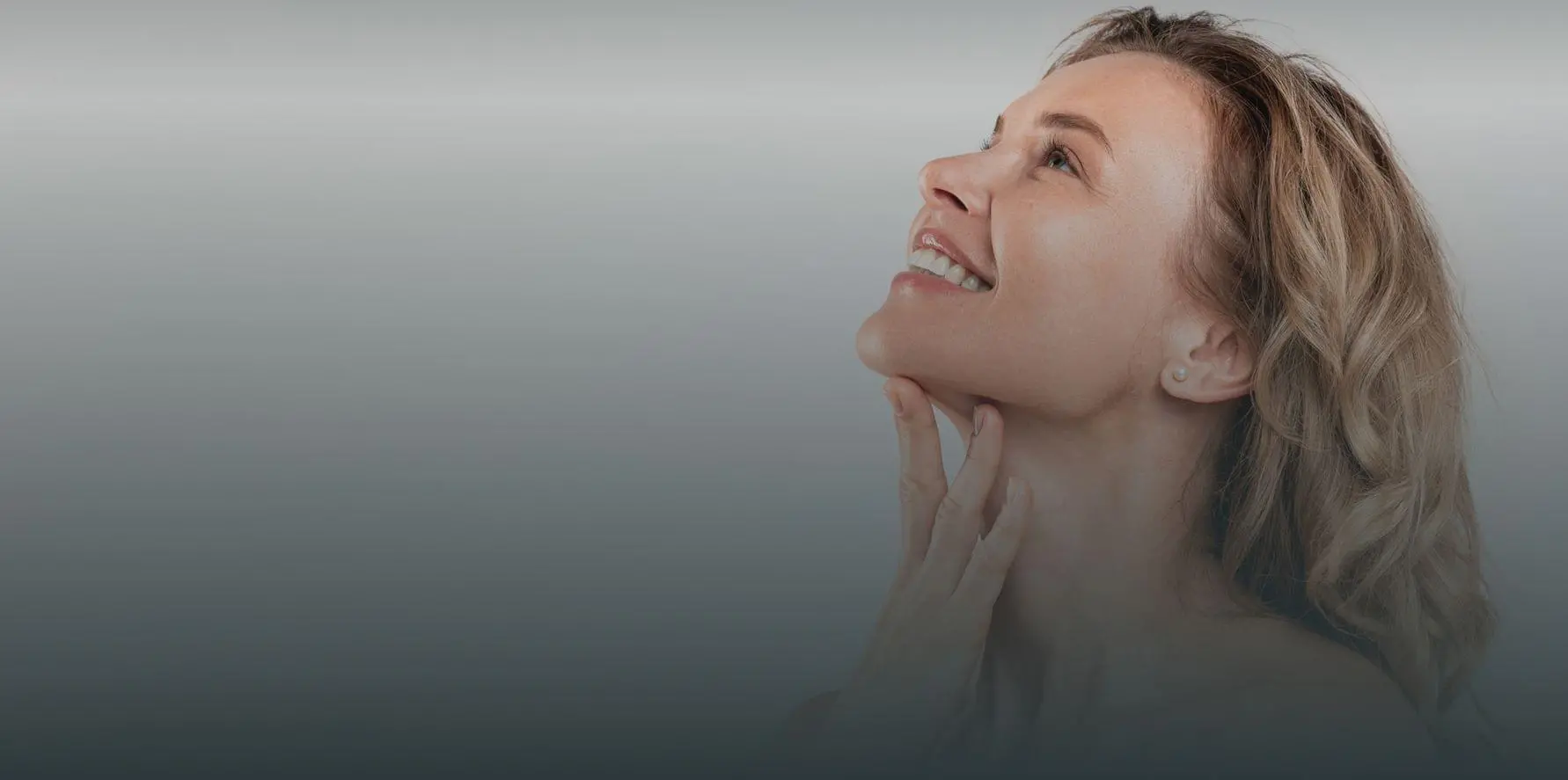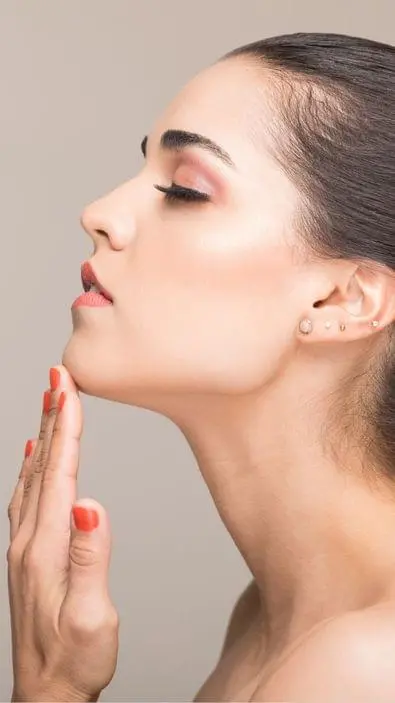
Chin Corrections
A well-shaped chin provides harmony in the facial profile. A small chin can make the nose look too big, thus creating an imbalance in facial aesthetics. While in women a delicate chin is perceived as beautiful, a prominent, broad chin is considered particularly masculine. In the frontal view, regardless of gender, the forehead, the length of the nose and the mouth/chin area should be in a ratio of one third each.
Chin Corrections:
The facts
Length of stay in the clinic
OutpatientAnesthesia
depending on the procedurelocal anaesthesia or sedation,
also on request Full anaesthesia/ General anaesthesia
Follow-up treatment
Local coolingResumption of social activities
after a few hours to a few days(depending on the procedure)
Pains
EasyDurability
ContinuousCost
from 4500.00 eurosWhen is a chin correction useful?
- For men and women who suffer from a so-called flying chin
- For patients whose own chin seems too small compared to the rest of the face
- If your own chin is perceived as too small and surgical chin reconstruction is not an option for the patient

Testimonials
After a long search I finally found the surgeon I trust! I have a complicated story about Prof. Dr. medical Sinis come. He encouraged me, but was honest with me at the same time.
Types of Chin Correction at Sinis Clinic Berlin
Similar to the cheek reconstruction, hyaluronic acid can be used as an injection method on site for chin reconstruction. In this procedure, the hyualornic acid is injected from the outsideinto the chin bone and is modelled bluntly, resulting in a harmonious overall shape of the face.
Own fat transplantation is also perfectly suited to chin reconstruction. The transplantation of autologous fat proceeds in the same way as when other body regions are built up with autologous fat. In this case, fat can be removed by liposuction analogous to cheek augmentation with the patient’s own fat. Afterwards, the fat tissue obtained can be injected into the chin region in the form of a lipotransfer.
If the fatty tissue has been incorporated and incorporated by the recipient area, the result can be considered stable in the long term. However, the chin region is not suitable for large volume transplants of autologous fat, so this procedure is only intended for smaller volume additions
The use of silicone implants on the chin is a particularly useful option for chin augmentation. The silicone implants can be inserted from intraorally (i.e. coming from the oral mucosa) or under the chin through a small skin incision to the lower jaw. The size of the chin implant is selected according to the patient’s wishes and then inserted via one of the two mentioned accesses, which is also coordinated with the patient. Chin plastic surgery or chin enlargement/chin augmentation can therefore be performed safely and in the long term for the patient.
The so-called genioplasty offers various options and surgical methods to harmonize the chin proportions depending on the initial situation. In addition to the chin correction methods that we have already explained, there are other procedures that can be used to achieve the desired results. Particularly effective is the chin reduction by means of the backward displacement of the chin bone as well as the chin reshaping with the help of the body’s own substances.
Chin reduction by means of chin bone reshaping:
This method involves chin correction by reducing the bone portion in the lower jaw if it is excessively large and there is an uneven proportion of the chin area to the entire face. Such an operation is one of the most extensive methods of genioplasty, which is also extremely effective. Here, a chin reduction or a recession of the chin is achieved by surgically reducing the tip of the chin bone. In the course of an operation lasting about one hour, the tissue below the visible chin area at the lower edge of the jaw is incised, making the chin bone accessible. This is then exposed at the front of the tip so that it can be surgically reduced. After sufficient bone material is removed, the opening is closed and then a supportive protective bandage is applied. However, such a chin correction is only possible if the bone structure basically allows it, i.e. is strong enough. This is because the functionality of the lower jaw must be guaranteed despite the reduced bone density. For this reason, a preliminary examination and bone density analysis are essential before such an operation.
Chin reshaping with the help of the body’s own substances:
This is a very frequently used surgical method and at the same time the best known form of genioplasty – the enlargement and/or reshaping of the entire chin area by inserting the body’s own bones or cartilage. Such a chin correction is usually performed whenever an underdeveloped chin area, the so-called receding chin, needs to be highlighted and/or emphasized. The method is performed in two stages or requires two interventions: First, the necessary cartilage or bone fragments are removed from the body and prepared for the actual reshaping of the chin. Then, depending on the prior determination of the most optimal incision, the tissue is incised either below the visible chin area at the lower edge of the jaw or on the inside of the mouth. The underlying bone area is exposed through the incision to make room for the prepared autologous material. The chin is then remodeled or given the desired shape. The individual parts are then fixed and the opening closed again. In this way, even a severely underdeveloped chin can be built up. This method of chin correction virtually eliminates the possible postoperative complications such as implant rejection. In addition, experience shows that the healing phase after surgery is largely free of complications and, above all, very fast.
In a malocclusion correction, the so-called dysgnathia, the lower jaw is moved either forward or backward. In order to maintain the angle between the lower jaw and the neck – and thus the aesthetic facial expression – a chin forward shift or a chin backward shift may be necessary. It is always advisable to first have the present malocclusion performed by an oral surgeon in order to then aesthetically adjust the proportions of the chin as part of a chin correction.
Without surgery, with the help of minimally invasive methods, only insignificant and sometimes temporary changes in the appearance of the chin are possible. Injections with hyaluronic acid, hydroxyapatite or autologous fat are used for this purpose. For chin correction, these substances are injected into the desired areas of the chin. However, the effect is not permanent – for example, hyaluronic acid lasts for about six to eight months. With hydroxyapatite, the effect lasts for about two years. Hydroxyapatite is a mineral mass that can be shaped as desired during the curing process. Only the patient’s own fat can remain more or less permanently, as it can fuse completely or partially.
Fundamental changes to the chin structure without surgery are simply impossible, however, as these are usually bone malformations. Neither chin enlargements nor chin reductions can be achieved with fillers, which is why invasive surgery is virtually without alternative. In such a case, it is therefore a matter of either accepting oneself as one is or accepting an operation. Orthodontic measures can also only correct a malocclusion, but cannot change anything about the chin itself.
Chin Correction Before/After
In order to be able to compare and evaluate the results achieved with the help of a chin correction, the before and after images are of course very suitable.
However, according to Section 11 Paragraph 1 Clause 3 of the German Medicines Advertising Act (HWG), we have been prohibited since April 1, 2006 from posting such pictures of patients in the publicly accessible media. However, it is quite possible for us to show you such recordings in the course of an individual consultation, so that you have the opportunity to compare your personal ideas with the results actually achieved. With the help of the recordings, you will certainly find out that a professionally performed surgical chin correction can lead to very natural results. Also, the comparison images can help you make a decision about the surgery if you haven't made up your mind yet.
After an operative chin correction, you will usually first be given sick leave, whereby the duration of the sick leave depends on the healing process. The postoperative hospital stay can vary depending on the scope of the intervention. You can usually leave the clinic at short notice even after major surgery. You will wear a special bandage for the first five to seven days after the operation. It is therefore important to follow the doctor's instructions regarding changing bandages and wound care, and to cool the chin locally. During this time, you should remain as calm as possible, as pain, bruising and swelling are unavoidable after such an operation, but experience has shown that these gradually subside after a few days. If the procedure was performed from the mouth, you should initially only drink lukewarm, clear drinks such as tea or water and later rinse your mouth out well after every meal.
However, if the intervention was carried out from the outside, nothing changes when eating and drinking. You should only sleep on your back with your head elevated for at least two weeks. You should also avoid exertion that increases blood pressure — such as bending over, lifting heavy objects, straining during a bowel movement, or blowing your nose vigorously. In the first period after the operation, you should also not put any pressure on your chin and follow all medical recommendations.
After an extensive surgical chin correction, you should completely refrain from smoking and drinking alcohol for the first few months, practice alternating showers and avoid direct sunlight. Sporting activities or other physical strains may only be increased very slowly in order not to overstretch the treated chin area. Depending on the suture technique, the outer threads are pulled out after about 10 to 14 days. The inner threads in the oral cavity usually do not have to be removed as they usually dissolve by themselves. If bones that were relocated during the operation were screwed and fixed with special plates, these will either remain in the body or be removed again, depending on the surgical procedure.
If the chin correction was carried out using bone removal or bone relocation, the result is permanent and is unlikely to recede. Implants that have been inserted usually remain for life without there being a need to replace them. However, if minimally invasive chin corrections were made by injecting fillers, the effect will recede after a while and it will have to be injected again.
A chin augmentation in which a bone displacement has been carried out can be reversed by means of bone removal. A chin augmentation using a natural or artificial implant can be done at any time.
removal of the implant can be reversed. A chin reduction can also be reversed by moving the bones forward or inserting an implant.
Risks of chin correction in Berlin
Basically, the chin correction in itself is an unproblematic procedure that usually does not entail any complications. However, many tendons, muscles and nerves meet in this region, so that permanent damage can occur if the operation goes wrong. If the nerves in the neck and/or face are injured or muscles are severed and not reconnected properly, this can result in permanent numbness, sensory disturbances and impaired facial expressions. In addition, primary complications such as infections or postoperative bleeding can sometimes occur - as would also be the case with any other operation. Taking antibiotics, as well as strict observance of hygiene rules, can almost completely eliminate this type of complication.
In the case of a chin augmentation, an incorrectly inserted and insufficiently fixed implant can also slip, which can be remedied by a further operation. The most common complications of a chin correction include pain, bruising and swelling, which, however, subside after a while by resting and cooling the chin area.
Costs of Chin Correction at Sinis Aesthetics Berlin
The costs of the initial consultation always depend on the type and extent of the treatment. In principle, the scale of fees for doctors applies to the consultation hours. Thereafter, patients pay 90 € for the initial consultation with anamnesis, collection of previous findings, physical examination and preparation of a therapy and cost plan. This fee is payable once and will not be credited towards further treatment.
Additional appointments and post-operative care are included in the total price of the operation and do not have to be paid separately. This is the only way to ensure a high-quality treatment with sufficient treatment time, during which we can respond to you and your specific needs. In order to ensure the success of the treatment, we have to carry out the consultation with sufficient time and care.
Unfortunately, we cannot quote an exact sum across the board, as the general conditions for each individual procedure and for each patient vary greatly. Every single operation is individual and accordingly requires an individual cost breakdown. The numerous aspects surrounding the operation, such as the type of chin advancement and the choice of surgical method and, if necessary, implants, are the decisive factors for the cost composition. The extent of the surgical intervention and how it is performed in detail is also relevant to costs.
In addition, qualified, specialist medical advice, treatment and control appointments, hospital stays as well as the special dressing articles are included in the total price. At least one non-binding consultation is required, during which the cost of chin correction in the case of chin advancement as well as personal expectations are clarified and the approximate cost of the operation is determined. In order to give you an overview, we can give you a guideline: The total cost is usually at least 2500 euros, although it can vary greatly upwards.
However, a detailed overall view of the costs incurred for the specific individual case is only possible if all necessary aspects are taken into account.
A chin that is too small or too large does not usually affect the health of the person concerned, so that this circumstance cannot be considered a disease. Therefore, a chin correction is usually an aesthetic intervention that is not necessary from a purely medical point of view. Because of this, neither the statutory nor the private health insurance companies usually cover the costs of such an operation.
However, the costs may be covered by the health insurance if the chin correction is necessary for medical reasons. For example, the need for chin correction may have arisen as a result of an accident or other condition. This sometimes includes serious psychological conditions that have arisen in connection with the external appearance. Even in the case of a malocclusion, your health insurance should be consulted to determine if the cost is covered by your health insurance. In case of doubt, it would be advisable to consult your health insurance company before the operation.
You can also quickly find out whether a private health insurance company will cover or contribute to the costs of a chin correction in such exceptional situations by calling your health insurance company.
Consultation
Open continuously from Tuesday 08.00 to Saturday 14.00
Open continuously from Tuesday 08.00 to Saturday 14.00

